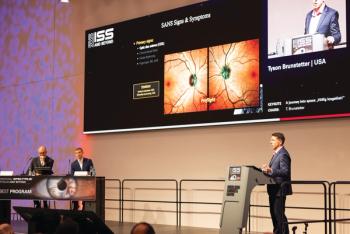
Corneal ulcers demand urgent treatment
Avoiding permanent damage calls for more aggressive treatment, occasional 'scare' tactic
Dr Autry, an optometric physician, pharmacist, and partner in a private practice referral center in Texas, lectured on the diagnosis and treatment of corneal ulcers with Dr Louise A. Sclafani, associate professor of surgery, University of Chicago Hospitals.
Dr Autry and Dr Sclafani both emphasized the importance of distinguishing between inflammatory and infectious ulcers. If the corneal ulcer is unquestionably infectious, her approach is to start the patient on antibiotics as frequently as every 30 minutes or, at the least, every 1 to 2 hours, rather than every 4 hours.
Sterile infiltrates, in contrast, typically cause only mild pain and are marked by multiple small lesions. They are located in the periphery and do not have a discharge. The epithelium is intact, the anterior chamber quiet, and focal accumulation of inflammatory cells is present, according to Dr Sclafani. These factors were outlined in a pivotal study on infiltrative keratitis by Stein et al. in 1988.
Using cases from their respective practices, Dr Sclafani and Dr Autry offered other important tips for managing corneal ulcers.
Dr Sclafani discussed the case of a college student who was referred from student health services because of a red, photophobic left eye. Following an examination, the student was diagnosed with sterile marginal infiltrate - secondary to contact lens wear with a possibility of microbial keratitis.
Dr Sclafani recommended continued use of erythromycin ointment and starting a steroid/antibiotic combination. However, she was concerned about starting a steroid on a Friday afternoon, given the patient's suspected history of noncompliance with recommended practices for contact lens wear.
Hoping to convince the patient to take the medication, Dr Sclafani tried a technique that sometimes helps in cases like these, the "scare tactic" of showing patients graphic pictures of corneal ulcers.
She also took the patient's remaining contact lenses away, refused to give her new ones until later, and gave her an updated prescription for glasses.
Inquire about eyeglasses
The case study that Dr Sclafani presented brings up another key point: ask detailed questions about the patient's glasses. Dr Autry noted that while many patients who abuse contact lenses say they have a pair of glasses at home. They will not wear the glasses because the prescription is no longer correct or the frame style is outdated.
"If they had nicer, more up-todate glasses, they might be less likely to wear their contact lenses 24 hours a day," Dr Autry said. "And this might be an opportunity for the optometrist to recommend a new prescription."
Another pointer is to always remember to look in the fellow eye. Doing so in the case of the college student indicated that she was a chronic abuser of contact lenses and the symptoms that brought her to the practice might not have been an isolated incident.
Newsletter
Get the essential updates shaping the future of pharma manufacturing and compliance—subscribe today to Pharmaceutical Technology and never miss a breakthrough.














































